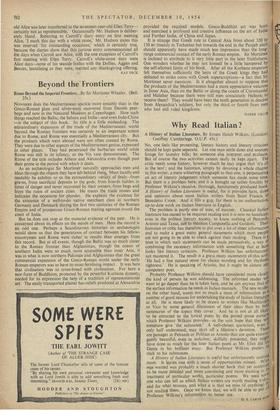Beyond the' Frontiers
Rome Beyond the Imperial Frontiers. By Sir Mortimer Wheeler. (Bell. 25s.)
NOWHERE does the Mediterranean sparkle more amiably than in the Greco-Roman glass and silver-ware recovered from Danish peat- bogs and now in the National Museum at Copenhagen. How such things reached the Baltic, the Sahara and India—and even Indo-China —is the subject of this book. Its title is a little misleading. The extraordinary expansion of the trade of the Mediterranean world beyond the Roman frontiers was certainly to an important extent due to Rome, and Rome was essentially a Mediterranean city. But the products which went abroad were not often created by Rome. They were due to other aspects of the Mediterranean genius, expressed in other places. They had penetrated the barbarian world while Rome was still in its infancy, as the Vix vase demonstrates. The Rome of the title includes Athens and Alexandria even though past their prime in the period with which it deals.
As an archmologist Sir Mortimer naturally approaches men and ideas through the objects they have left behind then Most lucidly and readably he exhibits to us the extraordinary variety of finds—from graves, from sacrificial deposits to the gods, from hoards hidden in times of danger and never recovered by their owners, from bogs and from the ruins of ancient cities. He traces the trade routes and indicates the occasions for plunder. He explains the evidence for the existence of a well-to-do native merchant class in northern Germany and Denmark during the first two centuries of the Roman Empire and of prosperous Greco-Roman trading agencies round the coast of India.
But he does not stop at the material evidence of the past. He is concerned about its effects on the minds of men. Here the record is an odd one. Perhaps a Scandinavian historian or archteologist would show us that the generations of contact between his fellow- countrymen and Rome were richer in results than emerges from this record. But at all events, though the Baltic was so much closer to the Roman frontier than Afghanistan, though the coasts of southern India were so much more accessible than inner Asia, it was in what is now northern Pakistan and Afghanistan that the great commercial expansion of the Greco-Roman world under the early Roman emperors was to have its most fertilising impact, It was here that civilisation was to cross-breed with civilisation. For here a new form of Buddhism, protected by the powerful Kushana dynasty, needed for its expression the help of a tradition of representational art. The easily transported plaster bas-reliefs produced at Alexandria
provided the required models. Greco-Buddhist art was born and exercised a profound and creative influence on the art of India and Further India, of China and Japan.
It is strange that Greek rule in Central Asia from about 320 to 130 BC (mainly in Turkestan but towards the end in the Punjab also) should apparently have made much less impression than the long- range commercial contact of the early Roman empire. Sir Mortimer is inclined to attribute to it very little part in the later fruitfulness. One wonders whether he may not himself be a little hampered by the self-allotted limits of his book. After all the Kushana emperors felt themselves sufficiently the heirs of the Greek kings they had defeated to strike coins with Greek superscriptions—a fact that Si' Mortimer never mentions. Is it altogether absurd to suppose that the products of the Mediterranean had a more appreciative welconie in Inner Asia, than on the Baltic or along the coasts of Coromandel and Malabar because there were still men consciously Hellenic to receive them? They would have been the tenth generation in descent from Alexandria's soldiers, but only the third or fourth from men who had still ruled kingdoms.
DARSIE (.11 I IS








































 Previous page
Previous page